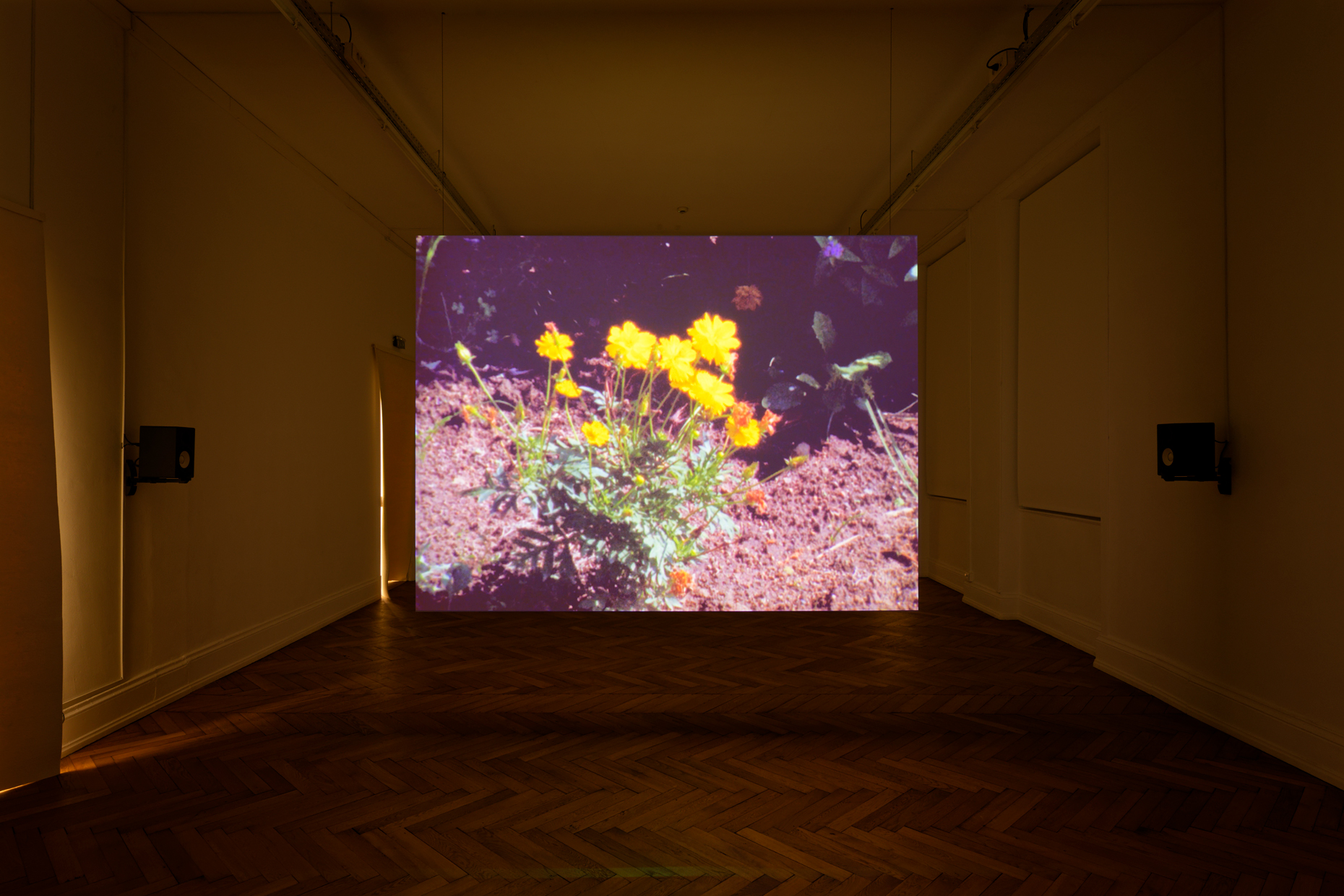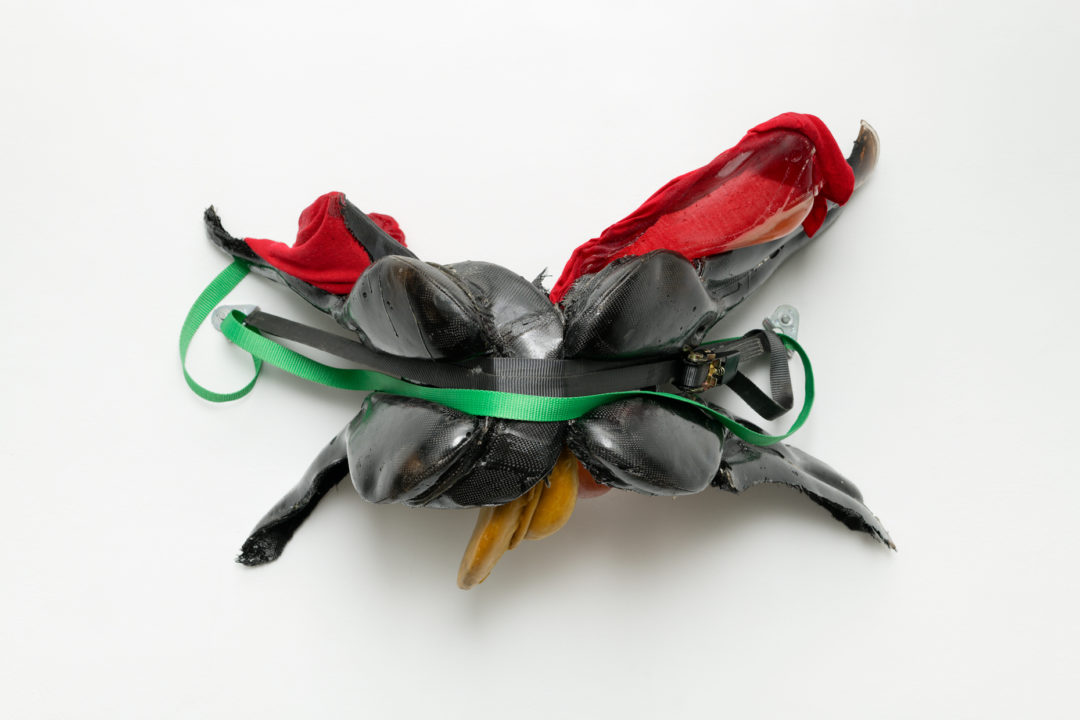June Crespo, Mathilde Rosier et Ana Vaz at CRAC Altkirch

“The bark”
15.10.23 – 14.02.23
This winter, the CRAC is looking like a cabaret. A slightly ghostly, petrified cabaret. No French-Cancan dancers, but Mathilde Rosier’s half-human, half-plant creatures, undulating in an agrarian dance. On stainless steel tubes resembling pole-dancing bars, bronze riding saddles have replaced the whirling bodies, which have vanished without taking the time to gather their belongings: here a powder pink corset is lying around, there a metallic blue cocktail dress. Further on, the theatre red curtain has become a suspension for acrobatics, perhaps using Japanese shibari techniques, which we can also sense in the tangles of straps, ribbons, and leather. Emptied of any living presence, June Crespo’s sculptures are no less sensual and sexual, alternating between chaste concealment beneath transparent veils and the raw rubbing of materials between denim and bronze. In Winter, the saddle seems to be doing penance, while Summer shows us its gaping, almost surgical orifice. With Mathilde Rosier and Ana Vaz, the party is in its last throes. For the first, a chromatic palette in disco tones, a little hallucinatory, costumed hybrid divas floating surrounded by waves. For the other, fireworks filmed ever more rapidly, a stroboscopic effect before the great silence.

Perhaps after centuries of extraction, eradication, industrialisation and intensive agriculture, the party might finally be over. The little hairs on the merry-go-round have disappeared, and it seems to be squeaking its last few turns. There’s chemical residue from the asphalt, the smell of wax, and spectral presences. June Crespo’s Heart depicts constrained or quartered bodies; Ana Vaz reminds those of the eliminated indigenous peoples whose cave paintings are still visible at the bottom of the ravine she filmed; presence also in the passage of tyres in the ruts of Mathilde Rosier’s painted fields.
Or perhaps it’s the presence of the guardian spirit of Lastenia Canayo, whose paintings accompanied the conception of the exhibition. In the imminent blackout, another kind of reality seems to be emerging, a more supernatural and dreamlike one, that might just be able to save us. A counter-thought between resistance and reparation, which permeates the artists’ works. Like the reciprocity of guardian spirits, they suggest alternative models of communication. Mathilde Rosier scatters symbols and signs of a protolanguage across her canvases, with arrows and ears of wheat sliding towards the 1-0-0-1-1 of the binary code, which could serve as the basis for an inter-species language. June Crespo gives rhythm to the space with her punctuation sculptures in rounded shapes: moons, croissants, smiles, and exclamation marks. A rudimentary form of communication at the service of our emotions. She uses equestrian saddles, a contact medium that allows human and animal bodies to communicate and join forces.
This alliance quickly hybridizes. Mathilde Rosier’s paintings are inhabited by phantasmagorical beings combining human body parts with plant heads and tentacular arms. Tree stumps are hairy or bloody, missing halves of cut legs.
Under the spell of these mixtures, a purely anthropomorphic vision of the world gradually disappears. Just as after Hiroshima, Ana Vaz explains that “the impossibility of seeing the remnants of the disaster, the radioactive presence, calls on other senses to see them differently – ears, mouth, body”. This off-centred perception of the human being is expressed on screen when the camera zooms in on flowers in a garden cultivated in Naraha; but also in the ear when it broadcasts into space ultra-sounds – generated by the displacement of moving atoms – that are normally inaudible. By making us turn around the double screen to watch the film Atomic Garden, she makes us experience and accept the loss of information and the impossibility of knowing everything.

Scales are disrupted, the spatial scale shifting between micro and macro perspectives: from Mathilde Rosier’s wheat seed to the industrial infrastructure pipes that June Crespo hijacks. This generalised loss of reference points can be seen in Mathilde Rosier’s fantastical landscapes, where she alternates between tight, fragmentary shots and a cosmic infinity.
The temporal scale is also blurred by the energy flowing through Mathilde Rosier’s paintings, in the transition from inert to living, as in her glass sculptures, where seed-eyes have sprouted. The continuity of living things is also at play behind the camera in Ana Vaz’s film Look closely at the mountains. She intersperses shots of the mining sites that are ravaging the state of Minas Gerais in Brazil with shots taken in the Nord-Pas-de-Calais region, where mining waste has become a reservoir of biodiversity, protected and scrupulously analysed by scientists.
The dream is then obvious and pure as an ‘institution’, according to Ailton Krenak in Idées pour retarder la fin du monde (Ideas for delaying the end of the world). An alternative institution to our transformed and dying reality. A dream populated by parrots ready to fly away and escape their cages. Mathilde Rosier’s installation Lit cage avec Perroquet concludes the exhibition’s continuous chirping, a whisper that is almost invisible and banal yet delicately poetic. From the earliest animal domestication (6000 BC), to Icarus who dreamed of flying, to technological biomimetics, where the hummingbird’s flight inspired the wind power system, via the phoenix that rises from its ashes, to the parrots that imitate and repeat the spoken word, we need to follow the trail of birds to escape and dream of other places and other ensembles.
1 Ana Vaz and Olivier Marbeuf, « Parler l’ombre », conversation published in Talismans, Fondation Gulbenkian, 2018
______________________________________________________________________________
Head image : Ana Vaz, Atomic Garden, 2018. Installation vidéo, 16mn transféré en vidéo HD, son 6.1. Durée : 8’. Courtesy de l’artiste. Coproduit avec Spectre Productions, Rennes ; avec le soutien du CNAP, Paris et de la Fondation des Artistes, Nogent-sur-Marne. Photographie d’Aurélien Mole.
- From the issue: 107
- Share: ,
- By the same author: Moffat Takadiwa, Stanislas Paruzel at 40mcube, EuroFabrique In Romania,
Related articles
Ralph Lemon
by Caroline Ferreira
Ho Tzu Nyen
by Gabriela Anco
Hilma af Klint
by Patrice Joly

